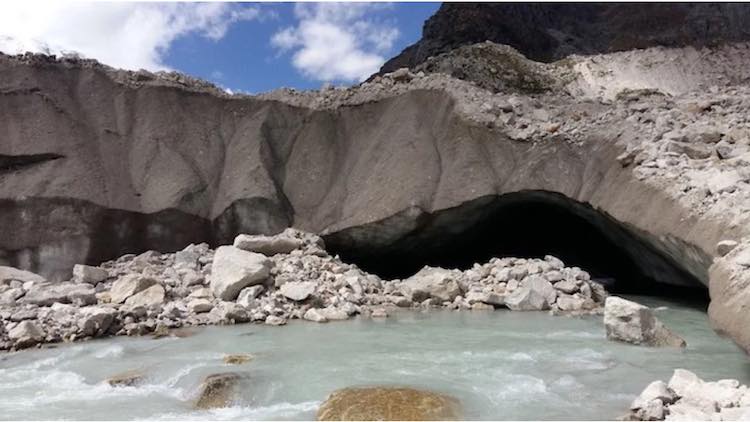Himalayan Rivers Must Be Lynchpin Of India’s New Water Policy

By Jayanta Bandyopadhyay/thethirdpole.net
As India prepares its new water policy, the importance of the rivers from the Himalayas cannot be overestimated.
The real origin of all rivers is the atmosphere. Precipitation pattern over river basins dictates the flow pattern of rivers. This vital link based on the provisioning ecosystem services of the atmosphere is hardly recognised in the reductionist mindset of traditional engineering. India’s new water policy has to recognise the need for deep scientific knowledge of the climate process in the Indian Himalayan Region (IHR). The larger Himalayan region is known as the water tower of Asia. The IHR is a part of it, and also includes most parts of the north-eastern states and hill areas of West Bengal. The large rivers emerging from the IHR are the Ganga, Brahmaputra, Barak (in the Meghna basin) and Indus. These rivers are joined by many tributaries from the Himalayan region, especially from Bhutan and Nepal. The Himalayan arc stands as a very tall (about 6,000 metres high) obstruction to the flows of the moisture-bearing atmospheric circulations, mainly the summer monsoon from June to September and the westerlies from November to February. This makes the Himalayas the climate maker of Asia and dictates the water endowment of these rivers. The monsoon results in very high precipitation as rain; and the westerlies generate precipitation that comes from Central Asia, largely as snow. The larger Himalayan region is also known as The Third Pole, as it stores about 12,000 cu km of glaciers, largest after the two global poles. This makes the rivers emerging from the IHR perennial and their flows account for about two-thirds of the total river flows of India. Food security and water supplies in north and east India depends on the IHR rivers. In 2018 the Niti Aayog (Indian government’s think tank) expressed serious concern about social and environmental damages of economic activities in the IHR and future demands on the IHR rivers. Integral links between groundwater and surface flows should be better recognised. Particular attention in relation to the IHR needs to be given to the possible use of aquifers in the foothill region, the Terai-Bhabar. From the east to the west of the IHR, there is a downward gradient in total annual precipitation, dominated by rainfall, and from the west to the east, a gradient exists in the snowfall content in the precipitation. Thus, the rainfall content in the flows of Ganga and Brahmaputra is very high, while for Indus, about half of the flow originates in snow and glacier melts. The Barak is fully rain-fed but its upper catchment is located at Cherrapungji, where the annual average precipitation is about 11,987 mm, according to Water Infrastructure for the Hindu Kush Himalayas, by David Molden and others in 2014.
The real origin of all rivers is the atmosphere. Precipitation pattern over river basins dictates the flow pattern of rivers. This vital link based on the provisioning ecosystem services of the atmosphere is hardly recognised in the reductionist mindset of traditional engineering. India’s new water policy has to recognise the need for deep scientific knowledge of the climate process in the Indian Himalayan Region (IHR). The larger Himalayan region is known as the water tower of Asia. The IHR is a part of it, and also includes most parts of the north-eastern states and hill areas of West Bengal. The large rivers emerging from the IHR are the Ganga, Brahmaputra, Barak (in the Meghna basin) and Indus. These rivers are joined by many tributaries from the Himalayan region, especially from Bhutan and Nepal. The Himalayan arc stands as a very tall (about 6,000 metres high) obstruction to the flows of the moisture-bearing atmospheric circulations, mainly the summer monsoon from June to September and the westerlies from November to February. This makes the Himalayas the climate maker of Asia and dictates the water endowment of these rivers. The monsoon results in very high precipitation as rain; and the westerlies generate precipitation that comes from Central Asia, largely as snow. The larger Himalayan region is also known as The Third Pole, as it stores about 12,000 cu km of glaciers, largest after the two global poles. This makes the rivers emerging from the IHR perennial and their flows account for about two-thirds of the total river flows of India. Food security and water supplies in north and east India depends on the IHR rivers. In 2018 the Niti Aayog (Indian government’s think tank) expressed serious concern about social and environmental damages of economic activities in the IHR and future demands on the IHR rivers. Integral links between groundwater and surface flows should be better recognised. Particular attention in relation to the IHR needs to be given to the possible use of aquifers in the foothill region, the Terai-Bhabar. From the east to the west of the IHR, there is a downward gradient in total annual precipitation, dominated by rainfall, and from the west to the east, a gradient exists in the snowfall content in the precipitation. Thus, the rainfall content in the flows of Ganga and Brahmaputra is very high, while for Indus, about half of the flow originates in snow and glacier melts. The Barak is fully rain-fed but its upper catchment is located at Cherrapungji, where the annual average precipitation is about 11,987 mm, according to Water Infrastructure for the Hindu Kush Himalayas, by David Molden and others in 2014.

Latest Videos
















